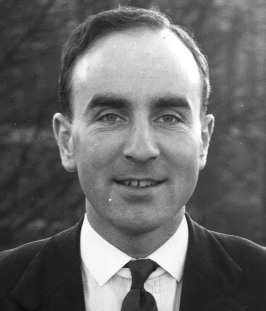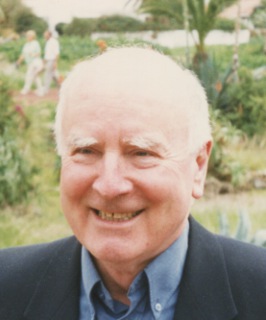| 2014 |
We are sad to report that October 2013 saw the death of Norman Gerald (Gerry) McCrum - a long-serving member of academic staff of the Department of Engineering Science. He had a passionate interest in teaching of materials within the engineering context. Alumni will probably remember him best for his enthusiastic lectures and lab classes on 'Engineering Materials'. They were always accompanied by reams of hand-written notes before lecture notes became the norm. As a researcher, Gerry was particularly interested in polymers. Alumni may recall these were well represented in his teaching on materials: right from the mid '60s when it was much less usual to teach polymers to engineers. They were only just becoming accepted as respectable engineering materials.
Gerry was born and grew up in the North of England, but in 1942 the family moved south and he attended Loughborough Grammar School. Apart from school work he developed great interests in cricket and bell-ringing. National Service in the Royal Artillary followed, after which he went up to Oxford to St Catherine's Society (now St Catherine's College), to study Physics. Here he loved to play tennis and also explored real tennis and country dancing. Graduating in 1951, Gerry stayed on at the Clarendon Laboratory to undertake research in low-temperature physics, completing his DPhil in 1954.

|
For his first job Gerry moved to the USA, and gained a taste for teaching as Assistant Professor in the Physics Department of Pennsylvania State University. However industry beckoned, and after two years he moved to the huge US chemical company E.I.DuPont de Nemours, at their famous corporate research laboratory: the DuPont Experimental Station near Wilmington, Delaware. He joined as Research Assistant and was later promoted to Research Associate. This must have been an exciting time. The Experimental Station was one of the few labs in the world where the new synthetic polymers were being developed. To name just a few: nylon, PTFE and Kevlar were first created there. Gerry was in the midst of this, working in the Polychemicals Research Laboratory. He became a leading researcher of the mechanical properties of these new materials, especially their distinctive viscoelastic properties. By the time he left five years later, he was already known internationally as an expert on this topic. By this time he was also married, to Carolyn Palmer Henry, with two sons Oliver and Christopher. Daughter Anna arrived later.
In 1962 Gerry moved with his family back to the UK, to a research position at the Cavendish Laboratory in Cambridge, in the Laboratory of the Physics and Chemistry of Solids. Here he continued working on the viscoelasticity of polymers. He developed new approaches for studying and characterising the inter-relationships between time, frequency and temperature dependence of the mechanical response of polymers, and their links to the structures of these materials.
From Cambridge, Gerry was recruited in 1963 by the Department of Engineering Science at Oxford, initially to the post of Senior Research Officer: he became University Lecturer in 1966. Around this time too, Gerry began his long association with Hertford College: he was elected C.E.G.B. Research Fellow in 1964, and then Official Fellow in 1966. He remained in these posts until he retired in 1994. After retiring he was elected Emeritus Fellow at Hertford. Thus Gerry was one of a group of lecturers who arrived in the early '60s and were instrumental in growing the Department substantially, under the leadership of Head of Department Professor Douglas Holder. By then, the Department had outgrown its original home, now known as the Jenkin Building, and the prominent and (at the time) ultra-modern Thom Building, with its distinctive shape and aluminium and glass façade, was completed in 1963. My first memory of Gerry is of meeting him in Hertford lodge on arrival for my college admissions interview in late 1964, and of him surprising me by excitedly asking "Have you seen the new building?"
During the following two decades Gerry built a lively research group, which became well known for work on understanding and modelling of polymer viscoelasticity: a topic of importance in the burgeoning applications of polymers as engineering materials. He was also busy writing - many journal articles and some books. In 1967 Wiley published his book (with Brian Read and Graham Williams) "Anelastic and Dielectric Effects in Polymeric Solids". It became a classic of the field, and was later re-published as a Dover paperback. There are several reasons for its success. The book is certainly well-written, but it also met a real need. Anelastic and dielectric performances of polymers are not only of intrinsic engineering importance, they are also extremely useful for routine characterisation of polymers. Commercially-produced so-called DMA (Dynamic Mechanical Analysis) instruments have become ubiquitous in polymer labs throughout the world, and McCrum, Read and Williams remains to this day arguably the best guide to interpretation of the data. At that time, industrial interest in polymers was growing rapidly, partly because of their usefulness to bind the fibres together in new, light-weight, fibre composite materials. This aspect of them also attracted Gerry's interest, and in 1971 HMSO (for the Ministry of Technology) published his monograph "A Review of the Science of Fibre Reinforced Plastics".
In his lab during the '70s, one of the pioneering achievements of Gerry and his team was to develop equipment for doing 'T-jump' experiments on polymers, whereby the temperature of a sample of material is changed extremely rapidly during, say, creep deformation. This is an elegant means of measuring the activation energy of a deformation process: a useful number in gaining physical insight into what is going on. Gerry and co-workers applied it with success to a variety of materials. They even extended it to biological soft tissues: a challenging exercise indeed. The distinction of Gerry's research on polymers by this time was recognised in 1975 by the award of DSc by the university. As the decade ended, Gerry divorced in 1979.
In the early '80s Gerry met and married his second wife, Carolyn MacKinnon. He acquired new interests that he and Carolyn pursued together, including acting as judges of the Oxfordshire Best Kept Village Competition. As this decade progressed, Gerry became keen to share in book form the many ideas and notes he had amassed, on teaching of polymers to engineers, and his next major writing project was born: "Principles of Polymer Engineering" first published (with myself and Clive Bucknall as co-authors) by OUP in 1988, together with a separate Solutions Manual. This proved a rather popular text-book: a second edition was published in 1997; and a third edition is currently in preparation. At the same time, Gerry also contributed to development of the subject of polymer engineering more generally, as editor of the Institute of Materials peer-reviewed journal "Plastics, Rubber and Composites, Processing and Applications", from 1989 to 1997.
It was during the years when we were working on the first edition of the text-book, that Gerry told me of a new passion: to develop a public gallery in Oxford, presenting the intellectual contributions made by the University of Oxford over the centuries. He said it was inspired by a radio interview given by Sir Keith Joseph (a Minister in the Thatcher cabinet) complaining that universities were too reticent in 'selling' their achievements. Thus was conceived 'The Oxford Story', for which Gerry campaigned, and energetically sought funding from various sources. Eventually the funds were raised, and it was established in Broad Street as a popular attraction, drawing two million visitors over 20 years. It was a fascinating and graphic narrative of the history of the city, as well as of the university and the ideas it had spawned, from the Middle Ages to the present day.

|
In his last few years before retiring, and for several years after that, Gerry passionately pursued another line of research. He undertook statistical analyses of some contentious issues that were worrying some people in the university. Was there any bias in Oxford undergraduate admissions? Was there gender bias in university teaching and examining? Armed with spreadsheets and copious data, he showed that the Oxford interview seemed to introduce unintentional bias into admissions decisions. Also, there seemed to be in-built bias in favour of men in university examining of many subjects. These uncomfortable discoveries were published not only in Oxford's in-house "Oxford Magazine", but also in some educational journals. They prompted much discussion and further investigation in Oxford and elsewhere.
An infectious enthusiasm was characteristic of Gerry's pursuit of all his many interests, as was his particular delight in challenging the status quo. Those of us lucky enough to have been his research students gained enormously from this. His passions for struggling to obtain the best possible experimental data, and for treating each research question being addressed as of the utmost importance, were very inspiring and motivating for a student learning the ropes in experimental research. At the same time, Gerry would show great kindness and understanding to those he worked with. There are many former students and colleagues who owe him a lasting debt of gratitude. He will be greatly missed.
The photos of Gerry McCrum are shown by courtesy of Mrs Carolyn McCrum
| << Previous article | Contents |
| SOUE News Home |
Copyright © 2014 Society of Oxford University Engineers |
SOUE Home |